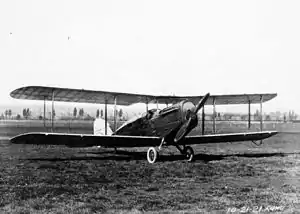Dayton-Wright Cabin Cruiser
The Dayton-Wright KT Cabin Cruiser was a 1920s American three-seat touring aircraft built by the Dayton-Wright Airplane Company in Dayton, Ohio.[1] Often known as the "Honeymoon Express", it was one of several civilian aircraft the company developed from the de Havilland DH.4.
| KT Cabin Cruiser | |
|---|---|
 | |
| Role | Three-seat touring aircraft |
| Manufacturer | Dayton-Wright Airplane Company |
| First flight | 1921 |
| Developed from | de Havilland DH.4 |
Design and development
The Dayton-Wright Airplane Company had built 3,106 de Havilland DH.4s under license during the First World War. After the war ended, the company looked to develop civil transports. The resulting KT Cabin Cruiser was a standard production DH.4 with a glazed enclosure for two passengers in tandem-seat configuration in the front, and a pilot in the rear, under a continuous glazed canopy. Because of the intimate side-by-side accommodations for the front passengers the aircraft was popularly known as the "Honeymoon Express". Another more basic conversion from the DH.4 was the Nine-Hour Cruiser which retained the open cockpit with room for two passengers behind but had an increased fuel load.
Specifications (KT Cabin Cruiser)
Data from The Illustrated Encyclopedia of Aircraft (Part Work 1982-1985).
General characteristics
- Crew: One
- Capacity: 2 passengers
- Length: 30 ft 1.5 in (9.18 m)
- Wingspan: 43 ft 7.5 in (13.30 m)
- Height: 11 ft 2.5 in (3.42 m)
- Wing area: 441.09 sq ft (40.98 m2)
- Empty weight: 2,686 lb (1,218 kg)
- Max takeoff weight: 4,128 lb (1,872 kg)
- Powerplant: 1 × Liberty 12 inline piston, 420 hp (313 kW)
Performance
- Maximum speed: 120 mph (193 km/h, 100 kn)
Armament
- Guns: one 0.293 in (7.45 mm) machine-gun
See also
Aircraft of comparable role, configuration, and era Dayton-Wright OW.1 Aerial Coupe
References
| Wikimedia Commons has media related to Dayton-Wright Cabin Cruiser. |
- Aerial Age: 5. 15 March 1920. Missing or empty
|title=(help)
- The Illustrated Encyclopedia of Aircraft (Part Work 1982-1985). Orbis Publishing.